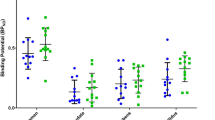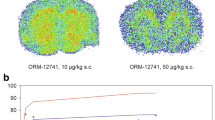Abstract
PET assessment of the adenosine A2a receptors localized in the striatum offers us a potential new diagnostic tool for neurological disorders. In the present study, we carried outin vitro receptor autoradiography of a newly developed PET ligand [11C]KF18446 ([7-methyl-11C]-(E)-8-(3,4,5-trimethoxystyryl)-1,3,7-trimethylxanthine) with rat brain sections. [11C]KF18446 showed a high striatum/cortex binding ratio (5.0) and low nonspecific binding (<10%), suggesting that [11C]KF18446 has characteristics comparable or slightly superior to [3H]CGS 21680 or [3H]SCH 58261, which are currently available representative A2a receptor ligands. Scatchard analysis indicated a Kd of 9.8 nM and a Bmax of 170 fmol/mm3 tissue in the striatum and a Kd of 16.4 nM and a Bmax of 33 fmol/mm3 tissue in the cortex. Seven xanthine-type and four nonxanthine-type adenosine receptor ligands with an affinity for the adenosine A2a receptors significantly reduced thein vitro binding of [11C]KF18446 to the brain section. The blocking effects were much stronger in the striatum than in the cortex, but did not necessarily parallel their affinity. On the other hand, four xanthine-type ligands and one nonxanthine-type ligand (SCH 58261) of the 11 ligands studied reduced thein vivo uptake of [11C]KF18446 in mice, but other ligands, including A1-selective and nonselective ligands and three nonxanthine-type A2a-selective antagonists did not. We conclude that [11C]KF18446 is a promising adenosine A2a receptor ligand for PET study.
Similar content being viewed by others
References
Fredholm BB, Abbracchio MP, Burnstock G, Daly JW, Harden TK, Jacobson KA, et al. Nomenclature and classification of purinoceptors.Pharmacol Rev 46: 143–156, 1994.
Palmer TM, Stiles GL. Adenosine receptors.Neuropharmacology 34: 683–694, 1995.
Ongini E, Fredholm BB. Pharmacology of adenosine A2A receptors.Trends Pharmacol Sci 17: 364–372, 1996.
Lewis ME, Patel J, Edley SM, Marangos PJ. Autoradiographic visualization of rat brain adenosine receptors usingN 6-cyclohexyl[3H]adenosine.Eur J Pharmacol 73: 109–110, 1981.
Goodman RR, Snyder SH. Autoradiographic localization of adenosine receptors in rat brain using [3H]cyclohexyl-adenosine.J Neurosci 2: 1230–1241, 1982.
Fastbom J, Pazos A, Palacios JM. The distribution of adenosine A1 receptors and 5′-nucleotidase in the brain of some commonly used experimental animals.Neuroscience 22: 813–826, 1987.
Pagonopoulou O, Angelatou F, Kostopoulos G. Effect of pentylentetrazol-induced seizures on A1 adenosine receptor regional density in the mouse brain: a quantitative autoradiographic study.Neuroscience 56: 711–716, 1993.
Fastbom J, Pazos A, Probst A, Palacios JM. Adenosine A1 receptors in the human brain: a quantitative autoradiographic study.Neuroscience 22: 827–839, 1987.
Svenningsson P, Hall H, Sedvall G, Fredholm BB. Distribution of adenosine receptors in the postmortem human brain: an extended autoradiographic study.Synapse 27: 322–335, 1997.
Bruns RF, Lu GH, Pugsley TA. Characterization of the A2 adenosine receptor labeled by [3H]NECA in rat striatal membranes.Mol Pharmacol 29: 331–346, 1986.
Jarvis MF, Williams M. Direct autoradiographic localization of adenosine A2 receptors in the rat brain using the A2-selective agonist, [3H]-CGS 21680.Eur J Pharmacol 168: 243–246, 1989.
Parkinson FE, Fredholm BB. Autoradiographic evidence for G-protein coupled A2-receptors in rat neostriatum using [3H]-CGS21680 as a ligand.Naunyn Schmiedebergs Arch Pharmacol 342: 85–89, 1990.
Johansson B, Georgiev V, Parkinson FE, Fredholm BB. The binding of the adenosine A2 receptor selective agonist [3H]CGS 21680 to rat cortex differs from its binding to rat striatum.Eur J Pharmacol 247: 103–110, 1993.
Cunha RA, Johansson B, van der Ploeg I, Sebastião AM, Ribeiro JA, Fredholm BB. Evidence for functionally important adenosine A2A receptors in the rat hippocampus.Brain Res 649: 208–216, 1994.
Cunha RA, Johansson B, Constantino MD, Sebastião AM, Fredholm BB. Evidence for high-affinity binding sites for the adenosine A2A receptor agonist [3H]CGS 21680 in the rat hippocampus and cerebral cortex that are different from striatal A2A receptors.Naunyn Schmiedebergs Arch Pharmacol 353: 261–271, 1996.
Kirk IP, Richardson PJ. Further characterization of [3H]CGS 21680 binding sites in the rat striatum and cortex.Br J Pharmacol 114: 537–543, 1995.
Johansson B, Fredholm BB. Further characterization of the binding of the adenosine receptor agonist [3H]CGS 21680 to rat brain using autoradiography.Neuropharmacology 34: 393–403, 1995.
Schiffmann SN, Libert F, Vassart F, Vanderhaeghen JJ. Distribution of adenosine A2 receptor mRNA in the human brain.Neurosci Lett 130: 177–181, 1991.
Pollack AE, Harrison MB, Wooten GF, Fink JS. Differential localization of A2a adenosine receptor mRNA with D1 and D2 dopamine receptor mRNA in striatal output pathways following a selective lesion of striatonigral neurons.Brain Res 631: 161–166, 1993.
Martinez-Mir MI, Probst A, Palacios JM. Adenosine A2 receptors: selective localization in the human basal ganglia and alterations with disease.Neuroscience 42: 697–706, 1991.
Mally J, Stone TW. Potential role of adenosine antagonist therapy in pathological tremor disorders.Pharmacol Ther 72: 243–250, 1996.
Guieu R, Couraud F, Pouget J, Sampieri F, Bechis G, Rochat H. Adenosine and the nervous system: clinical implications.Clin Neuropharmacology 19: 459–474, 1996.
Ferré S. Adenosine-dopamine interactions in the ventral striatum. Implications for the treatment of schizophrenia.Psychopharmacology (Berl) 133: 107–120, 1997.
Baldessarini RJ. Drugs and the treatment of psychiatric disorders.In Pharmacological Bases of Therapeuitics (Eds. Goodman GA, Rall TW, Nies AS, Taylor P) Pergamon, New York, pp. 383–435, 1990.
Ferré S, O'Connor WT, Snaprud P, Ungerstedt U, Fuxe K. Antagonistic interaction between adenosine A2A receptors and dopamine D2 receptors in the ventral striopallidal system. Implications for the treatment of schizophrenia.Neuroscience 63: 765–773, 1994.
Shimada J, Suzuki F, Nonaka H, Ishii A, Ichikawa S.(E)-1,3-dialkyl-7-methyl-8-(3,4,5-trimethoxystyryl) xanthines: potent and selective adenosine A2 antagonists.J Med Chem 35: 2342–2345, 1992.
Baraldi PG, Cacciari B, Spalluto G, Borioni A, Viziano M, Dionisotti S, et al. Current development of A2a adenosine receptor antagonists.Current Med Chem 2: 707–722, 1995.
Müller CE, Stein B. Adenosine receptor antagonists: structures and potential therapeutic applications.Current Pharmaceut Design 2: 501–530, 1996.
Poulsen SA, Quinn RJ. Adenosine receptors: new opportunities for future drugs.Bioorg Med Chem 6: 619–641, 1998.
Zocchi C, Ongini E, Conti A, Monopoli A, Negretti A, Baraldi, PG, et al. The non-xanthine heterocyclic compound SCH 58261 is a new potent and selective A2A adenosine receptor antagonist.J Pharmacol Exp Ther 276: 398–404, 1996.
Poucher SM, Keddie JR, Singh P, Stoggall SM, Caulkett PW, Jones G, et al. Thein vitro pharmacology of ZM 241385, a potent, non-xanthine, A2a selective adenosine receptor antagonist.Br J Pharmacol 115: 1096–1102, 1995.
Palmer TM, Poucher SM, Jacobson KA, Stiles GL.125I-4-(2-[7-amino-2-{2-furyl} {1,2,4} triazolo {2,3-a} {1,3,5} triazin-5-yl-amino]ethyl)phenol, a high affinity antagonist radioligand selective for the A2a adenosine receptor.Mol Pharmacol 48: 970–974, 1995.
Zocchi C, Ongini E, Ferrara S, Baraldi PG, Dionisotti S. Binding of the radioligand [3H]-SCH 58261, a new non-xanthine A2A adenosine receptor antagonist, to rat striatal membranes.Br J Pharmacol 117: 1381–1386, 1996.
Fredholm BB, Lindström K, Dionisotti S, Ongini E. [3H]SCH 58261, a selective adenosine A2A receptor antagonist, is a useful ligand in autoradiographic studies.J Neurochem 70: 1210–1216, 1998.
Ishiwata K, Noguchi J, Toyama H, Sakiyama Y, Koike N, Ishii S, et al. Synthesis and preliminary evaluation of [11C]KF17837, a selective adenosine A2A antagonist.Appl Radiat Isot 47: 507–511, 1996.
Noguchi J, Ishiwata K, Wakabayashi S, Nariai T, Shumiya S, Ishii S, et al. Evaluation of carbon-11 labeled KF17837: a potential CNS adenosine A2a receptor ligand.J Nucl Med 39: 498–503, 1998.
Ishiwata K, Noguchi N, Sakiyama Y, Shimada J, Ishii S, Sakiyama T, et al. Synthesis andin vivo evaluation of11C-labeled xanthine derivatives as a PET tracer for mapping CNS and peripheral adenosine A2a receptors. The 12th International Symposium on Radiopharmaceutical Chemistry held in June 15–19, 1997, in Uppsala, Sweden.
Ishiwata K, Noguchi N, Wakabayashi S, Shimada J, Ogi N, Nariai T, et al. Carbon-11 labeled KF18446: a potential CNS adenosine A2a receptor ligand.J Nucl Med 41: 345–354, 2000.
Suzuki F, Ishiwata K. Selective adenosine antagonists for mapping central nervous system adenosine receptors with positron emission tomography: Carbon-11 labeled KF15372 (A1) and KF17837 (A2a).Drug Develop Res 45: 312–323, 1998.
Jacobson KA, Nikodijevic O, Padgett WL, Gallo-Rodriguez C, Maillard M, Daly JW. 8-(3-Chlorostyryl)caffeine (CSC) is a selective A2-adenosine antagonistin vitro andin vivo.FEBS Lett 323: 141–144, 1993.
Sarges R, Howard HR, Browne RG, Lebel LA, Seymour PA, Koe BK. 4-Amino[1,2,4]triazolo[4,3-a]quinoxalines. A novel class of potent adenosine receptor antagonists and potential rapid-onset antidepressants.J Med Chem 33: 2240–2254, 1990.
Suzuki F, Shimada J, Mizumoto H, Karasawa A, Kubo K, Nonaka H, et al. Adenosine A1 antagonists. 2. Structure-activity relationships on diuretic activities and protective effects against acute renal failure.J Med Chem 35: 3066–3075, 1992.
Müller CE, Geis U, Hipp J, Schobert U, Frobenius W, Pawlowski M, et al. Synthesis and structure-activity relationships of 3,7-dimethyl-1-propargylxanthine derivatives, A2A-selective adenosine receptor antagonists.J Med Chem 40: 3496–4405, 1997.
Ishiwata K, Ogi N, Tanaka A, Senda M. Quantitativeex vivo andin vitro receptor autoradiography using11C-labeled ligands and an imaging plate: a study with a dopamine-D2 like receptor ligand [11C]nemonapride.Nucl Med Biol 26: 291–296, 1999.
Przedborski S, Levivier M, Jiang H, Ferreira M, Jackson-Lewis V, Donaldson D, et al. Dose-dependent lesions of the dopaminergic nigrostriatal pathway induced by intrastriatal injection of 6-hydroxydopamine.Neuroscience 67: 631–647, 1995.
Nonaka Y, Shimada J, Nonaka H, Koike N, Aoki N, Kobayashi H, et al. Photoisomerization of a potent and selective adenosine A2 antagonist, (E)-1,3-dipropyl-8-(3,4-dimethoxystyryl)-7-methylxanthine.J Med Chem 36: 3731–3733, 1993.
Nonaka H, Ichimura M, Takeda M, Nonaka Y, Shimada J, Suzuki F, et al. KF17837 ((E)-8-(3,4-dimethoxystyryl)-1,3-dipropyl-7-methylxanthine), a potent and selective adenosine A2 receptor antagonist.Eur J Pharmacol 267: 335–341, 1994.
Leo AJ. Calculating logP oct from structures.Chem Rev 93: 1281–1308, 1993.
Lindström K, Ongini E, Fredholm BB. The selective adenosine A2A receptor antagonist SCH 58261 discriminates between two different binding sites for [3H]-CGS 21680 in the rat brain.Naunyn Schmiedsbergs Arch Pharmacol 354: 539–541, 1996.
Author information
Authors and Affiliations
Corresponding author
Rights and permissions
About this article
Cite this article
Ishiwata, K., Ogi, N., Shimada, J. et al. Further characterization of a CNS adenosine A2a receptor ligand [11C]KF18446 within vitro autoradiography andin vivo tissue uptake. Ann Nucl Med 14, 81–89 (2000). https://doi.org/10.1007/BF02988585
Received:
Accepted:
Issue Date:
DOI: https://doi.org/10.1007/BF02988585




